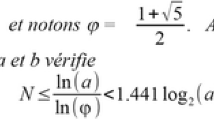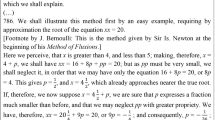Abstract
We examine teachers’ use of resources as they prepare to teach the topic of numerical series of real numbers, in order to identify how their personal relationship with mathematical content—and its teaching—interacts with their use of a commonly used textbook. We describe this interplay between textbook and personal relationship, a term coined in the Anthropological Theory of the Didactic (ATD, Chevallard, 2003), in terms of documentation work (resources, aims, rules of action, operational invariants), a key construct from the documentational approach (DA, Gueudet & Trouche, in Educational Studies in Mathematics, 71, 199–218, 2009). We do so in the case of five post-secondary teachers who use the same textbook as a main resource for teaching the topic. Documentational analysis of interviews with the teachers led to the identification of their aims and rules of action (the what and how of their resource use as they organise their teaching of the topic) as well as the operational invariants (the why for this organisation of their teaching). We describe the teachers’ documentation work in two sets of aims/rules of action: scaffolding mathematical content (series as a stepping stone to learning about Taylor polynomials and Maclaurin series), and organising student learning about series through drill exercises, visualisation, examples, and applications. Our bridging (networking) of theoretical constructs originating in one theoretical framework (personal relationship, ATD) with the constructs of a different, yet compatible, framework (documentation work, DA) aims to enrich the latter (teachers’ documentation work) with the individual agency (teachers’ personal relationships with the topic) provided by the former.


Similar content being viewed by others
Notes
The terms offloading, adapting, and improvising come originally from Brown (2009).
References
Adler, J. (2000). Conceptualising resources as a theme for teacher education. Journal of Mathematics Teacher Education, 3, 205–224.
Barbé, J., Bosch, M., Espinoza, L., & Gascón, J. (2005). Didactic restrictions on the teacher’s practice: The case of limits of functions in Spanish high schools. Educational Studies in Mathematics, 59(1), 235–268. https://doi.org/10.1007/s10649-005-5889-z
Brown, M. W. (2009). The teacher–tool relationship: Theorizing the design and use of curriculum materials. In J. T. Remillard, B. Herbel-Eisenmann, & G. Lloyd (Eds.), Mathematics teachers at work (pp. 17–36). New York: Routledge.
Charron, G., & Parent, P. (2004). Calcul intégral (3 e édition). Québec: Beauchemin.
Chevallard, Y. (1989). Le concept de rapport au savoir. Rapport personnel, rapport institutionnel, rapport officiel, Séminaire de didactique des Mathématiques et de l’Informatique. Université J. Fourier, Grenoble, 211-235.
Chevallard, Y. (2003). Approche anthropologique du rapport au savoir et didactique des mathématiques. In S. Maury & M. Caillot (Eds.), Rapport au savoir et didactiques (pp. 81–104). Paris: Fabert.
González-Martín, A. S. (2015). The use of textbooks by pre-university teachers: An example with infinite series of real numbers. In K. Krainer & N. Vondrovà (Eds.), Proceedings of the 9th congress of the European Society for Research in Mathematics Education (pp. 2124–2130). Prague: Charles University in Prague.
González-Martín, A. S., Nardi, E., & Biza, I. (2011). Conceptually-driven and visually-rich tasks in texts and teaching practice: The case of infinite series. International Journal of Mathematical Education in Science and Technology, 42(5), 565–589. https://doi.org/10.1080/0020739X.2011.562310
Gueudet, G. (2013). Digital resources and mathematics teachers’ professional development at university. In B. Ubuz, C. Haser, & M. A. Mariotti (Eds.), Proceedings of the eighth congress of the European Society for Research in Mathematics Education (pp. 2336–2345). Antalya: Middle East Technical University.
Gueudet, G. (2015). Resources, at the core of mathematics teachers’ work. In J. S. Cho (Ed.), Selected regular lectures from the 12 th international congress on mathematical education (pp. 235–251). Switzerland: Springer International Publishing.
Gueudet, G. (2017). University teachers’ resources systems and documents. International Journal of Research in Undergraduate Mathematics Education, 3(1), 198–224. https://doi.org/10.1007/s40753-016-0034-1
Gueudet, G., Buteau, C., Mesa, V., & Misfeldt, M. (2014). Instrumental and documentational approaches: From technology use to documentation systems in university mathematics education. Research in Mathematics Education, 16(2), 139–155. https://doi.org/10.1080/14794802.2014.918349
Gueudet, G., & Trouche, L. (2009). Towards new documentation systems for mathematics teachers? Educational Studies in Mathematics, 71, 199–218. https://doi.org/10.1007/s10649-008-9159-8
Kajander, A., & Lovric, M. (2009). Mathematics textbooks and their potential role in supporting misconceptions. International Journal of Mathematical Education in Science and Technology, 40(2), 173–181.
Love, E., & Pimm, D. (1996). “This is so”: A text on texts. In A. J. Bishop, K. Clements, C. Keitel, J. Kilpatrik, & C. Laborde (Eds.), International handbook of mathematics education: Part 1 (pp. 371–409). Dordrecht: Kluwer.
Mesa, V., & Griffiths, B. (2012). Textbook mediation of teaching: An example from tertiary mathematics instructors. Educational Studies in Mathematics, 79(1), 85–107. https://doi.org/10.1007/s10649-011-9339-9
Nardi, E., Jaworski, B., & Hegedus, S. (2005). A Spectrum of pedagogical awareness for undergraduate mathematics: From “tricks” to “techniques”. Journal for Research in Mathematics Education, 36(4), 284–316. https://doi.org/10.2307/30035042
Nicol, C., & Crespo, S. M. (2006). Learning to teach with mathematics textbooks: How preservice teachers interpret and use curriculum materials. Educational Studies in Mathematics, 62(3), 331–355. https://doi.org/10.1007/s10649-006-5423-y
Pepin, B., Grevholm, B., & Sträßer, R. (2006). DG07: The mathematics textbook – A critical artefact? In J. Novotná, H. Moraová, M. Krátká, & N. Stehlíková (Eds.), Proceedings of the 30 th Conference of the International Group for the Psychology of Mathematics Education (Vol. 1, p. 193). Prague: PME.
Raman, M. (2004). Epistemological messages conveyed by three high-school and college mathematics textbooks. Journal of Mathematical Behavior, 23(4), 389–404. https://doi.org/10.1016/j.jmathb.2004.09.002
Randahl, M. (2012a). First-year engineering students’ use of their mathematics textbook – Opportunities and constraints. Mathematics Education Research Journal, 24(3), 239–256. https://doi.org/10.1007/s13394-012-0040-9
Randahl, M. (2012b). Approach to mathematics in textbooks at tertiary level – Exploring authors’ views about their texts. International Journal of Mathematical Education in Science and Technology, 43(7), 881–896. https://doi.org/10.1080/0020739X.2012.662299
Weinberg, A., Wiesner, E., Benesh, B., & Boester, T. (2012). Undergraduate Students' self-reported use of mathematics textbooks. PRIMUS: Problems, Resources, and Issues in Mathematics Undergraduate Studies, 22(2), 152–175. https://doi.org/10.1080/10511970.2010.509336
Author information
Authors and Affiliations
Corresponding author
Rights and permissions
About this article
Cite this article
González-Martín, A.S., Nardi, E. & Biza, I. From resource to document: scaffolding content and organising student learning in teachers’ documentation work on the teaching of series. Educ Stud Math 98, 231–252 (2018). https://doi.org/10.1007/s10649-018-9813-8
Published:
Issue Date:
DOI: https://doi.org/10.1007/s10649-018-9813-8




